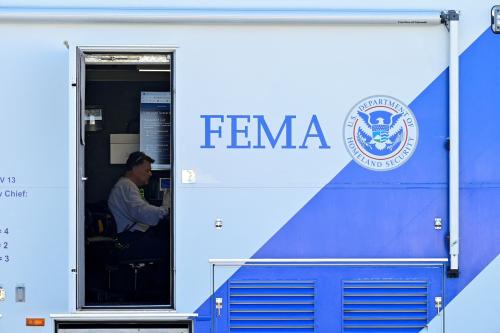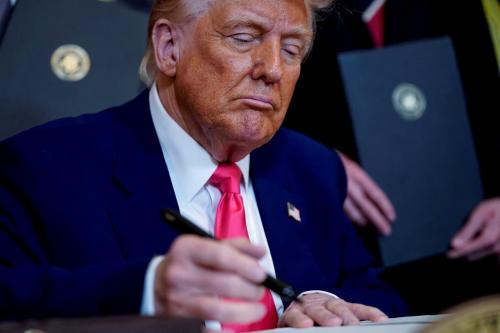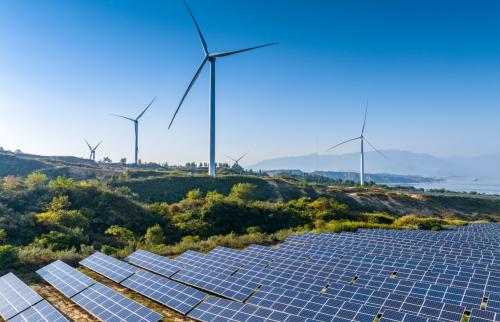Nuclear energy expansion represents a rare American policy topic that garners considerable political support across partisan and regional lines. During the 2020s, multiple bills have been adopted with Republican and Democratic backing that increase federal funding and regulatory support for industry expansion, including the 2024 ADVANCE Act. Both Joe Biden and Donald Trump have used executive powers to accelerate the development and deployment of next-generation reactors. A growing and diverse set of states are designing their own policies to complement federal ones in attempting to incentivize new nuclear energy development.
Nearly one-fifth of American electricity, more than the combined output from wind and solar at 16%, is produced by 94 nuclear reactors operating on 54 plants in 28 states. Two new reactors opened in Georgia in recent years; Michigan plans to restart a shuttered reactor later this year and intends to add smaller modular reactors on that site. More new launches may be in the offing, reflecting advancing technology, supportive policy, and recent Trump efforts to accelerate Nuclear Regulatory Commission (NRC) project approvals. In ways almost unthinkable a decade ago, nuclear energy appears to be making a stunning rebound after decades of controversy and decline. Even public opinion has shifted on this issue, trending upward after steep declines following earlier nuclear safety incidents in America and abroad.
Nuclear power is free of greenhouse gas emissions, unlike coal or natural gas, while also offering an ongoing electricity supply, unlike more intermittent renewables. It could contribute to a major expansion of total American electricity output, given anticipated demand spikes to support an era of proliferating data centers and artificial intelligence use. Nuclear is drawing increasing support from firms with substantial power needs, reflected in Pennsylvania’s recent decision to partner with Microsoft to reopen the Three Mile Island reactor, now renamed the Crane Clean Energy Center.
That growing chorus of nuclear enthusiasm quiets quickly, however, when the topic turns to nuclear waste. Can the United States address the long-simmering issue of managing high-level nuclear waste, spent nuclear fuel that must be removed from reactors and isolated from human contact for tens of thousands of years? On June 18, the Supreme Court released its most significant ruling on the issue in decades. In NRC v. Texas, a 6-to-3 majority decision dismissed state efforts to block NRC approval of an interim, above-ground storage facility in Andrews County proposed by a private firm, Interim Storage Partners.
The majority opinion, authored by Associate Justice Brett Kavanaugh, concluded that Texas and an allied mineral extraction firm lacked legal standing in the case. The decision did not definitively address whether the NRC retains legal authority to license a privately-operated interim facility for waste generated a long distance away. However, Kavanaugh noted that “history and precedent offer significant support for the commission’s longstanding interpretation” that it can do so.
If ultimately built, this interim facility could potentially store over two-fifths of the high-level waste produced nationally to date, roughly 90,000 metric tons. The decision may also open the path to completion of a separate storage facility in New Mexico, proposed by a different firm just across the border from the proposed Texas site. About 2,000 additional metric tons of this waste are produced annually, a volume which could increase if an envisioned expansion of the nuclear sector materializes in the coming decades, including modular reactors.
Legislation adopted during the 1980s was designed to resolve this issue through the construction of a geological repository for permanent disposal. It specified that site selection and facility development should be completed by 1999. But federal designation without local or state consent of a southern Nevada site, commonly known as Yucca Mountain, triggered decades of aggressive political and legal resistance at the state level. This included the creation of a Nevada agency that repeatedly challenged Yucca site suitability on environmental and technical grounds. It also emphasized that the state operated no nuclear reactors, contending that Nevada was being singled out unfairly to solve a national problem not of its making.
Decades later, most high-level nuclear waste continues to be stored at individual reactor sites, including those that no longer produce energy. President Barack Obama decided in 2010 to withdraw Yucca from serious site consideration despite over $15 billion invested in site development. President Donald Trump expressed interest in revisiting Yucca during the early stages of his first term but pivoted to opposition in 2020. Periodic congressional efforts to reopen this case have routinely faltered. The Project 2025 report strongly endorsed reconsideration of Yucca, and Energy Secretary Chris Wright did not rule this out during his confirmation hearings. But the second Trump administration, despite its considerable attention to nuclear energy expansion, has thus far not proposed to formally revisit Yucca or launch a new waste facility siting process. It has expressed interest in revisiting the idea of recycling or reprocessing spent nuclear fuel, although this approach was abandoned during the Ford-Carter years because of enduring concerns over steep costs, nuclear weapon proliferation risks, and creation of new waste streams.
Moving forward, the new Supreme Court decision would appear to give the Trump administration latitude to proceed with Texas site licensing, particularly given its expanding control over the NRC and recent flurry of executive orders to clear the path for further nuclear development. This green light also appears to apply to the related New Mexico proposal and could incentivize proposals for one or more additional storage facilities. However, several major questions remain.
First, while President Trump has issued an executive order to thwart state policies that threaten his plans to markedly expand domestic energy production, it is not certain that he would confront a state like Texas, which is so central to his political base, with a decision that would be very unpopular there. Elected Texas officials, including Governor Greg Abbott, Attorney General Ken Paxton, and the Texas Legislature, have vehemently opposed the interim storage facility proposal. Texas and New Mexico political leaders agree on very few energy policy issues, but are unified in their strong opposition to hosting interim storage facilities. New Mexico Governor Michelle Lujan Grisham decried the court decision as endorsing a “dangerous and irresponsible approach” to waste management.
Unlike Nevada and New Mexico, Texas has four nuclear reactors and has been enthusiastic about expanding nuclear energy output in the coming decades to help meet growing electricity demand and further enhance its role as a national and global energy technology leader. But it has continually drawn the line against hosting high-level nuclear waste storage. This opposition has emphasized potential risks to groundwater safety and oil and gas development in the Permian Basin region, where the proposed interim storage facility would be located, particularly given seismic activity linked to extraction. Associate Justice Neil Gorsuch, who authored the dissenting opinion, noted concerns about “radiated oil and gas” during oral arguments.
Second, the development of an interim facility would require complex shipments of nuclear waste, largely generated east of the Mississippi River, to a distant Southwest location. But once those shipments arrived, they would likely transform a strategy billed as temporary into a quasi-permanent one. This would divert attention from the subsequent development of a permanent waste management strategy and additional waste transfer.
States eliminating their responsibility for on-site storage would likely take an “out of sight, out of mind” approach to this larger challenge, saddling Texas and perhaps New Mexico with a de facto permanent burden of facilities not designed for that longer-term role. As Paxton noted, “Although the Commission describes this scheme as an ‘interim’ measure, the license has a forty-year term, is renewable, and is unaccompanied by any plan to transfer waste to a permanent repository.”
Third, the interim approach and lack of a long-term plan would ignore a series of recent major policy advances by other Western democracies with large nuclear energy operations and related waste accumulations. Finland is on the verge of opening a comprehensive geological repository following an extended deliberative process, and Sweden is following this model in developing its own repository. In these cases, permanent facilities will be located close to both existing and new reactors, backed by local political support.
In North America, Canada launched a process quite comparable to Finland’s several decades ago and in 2024 announced its selection of a final repository site near Ignace, Ontario. This followed extensive public engagement efforts and formal declarations of support from both local government and tribal authorities. Numerous communities were involved in a multi-stage voluntary process that provided far-reaching opportunities to review technical suitability and tailor any final agreement to meet local safety or economic considerations. This process has been an integral part of a Canadian initiative to expand domestic nuclear production and positions it to export its expertise in nuclear energy as well as waste management.
These cases reflect a deliberative and fundamentally different approach to nuclear waste facility siting than the one pursued in the United States since the 1980s, one that may not be politically feasible in the combative American political context. This idea has surfaced periodically during the national odyssey over high-level nuclear waste, most notably the 2012 Blue Ribbon Commission on America’s Nuclear Future, but it has never been formally adopted through legislation. A bill embracing this approach, the Nuclear Waste Administration Act, was introduced in the House with bipartisan sponsors last year but has not resurfaced in the current Congress.
A growing American policy debate quite appropriately considers ways to accelerate decisions on energy infrastructure siting and permitting. High-level nuclear waste management has largely been ignored in these conversations, perhaps because it seems so intractable. But such waste presents unique political and public health challenges that extend over exceptionally long time frames. As the United States continues its prolonged struggle over this issue, other advanced democracies offer credible lessons on how to address it permanently rather than relying on temporary fixes that will inevitably have to be revisited.
The Brookings Institution is committed to quality, independence, and impact.
We are supported by a diverse array of funders. In line with our values and policies, each Brookings publication represents the sole views of its author(s).








Commentary
The enduring dilemma of managing American high-level nuclear waste
July 11, 2025